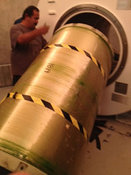
Gradient coil set being replaced.
Your confusion is justified. The term "gradient" is used in two different ways.
First, as in the previous question, gradient describes how a magnetic field changes in space. An ideal, uniform magnetic field in a vacuum contains no gradients. However, all real-life MR magnets have gradients due to field imperfections (inhomogeneities). Additionally, any object in the scanner (e.g., the human body) interacts with and distorts the field, an effect called susceptibility.
In its second use, gradient is used synonymously with gradient coils, a set of electromagnets embedded in the body of the MR magnet assembly. When an electrical current is passed through these coils, the main magnetic field is focally distorted in certain places, creating magnetic gradients of the first kind. Gradient coils alter the main magnetic field in a predictable manner in the x-, y-, and z-directions and are used to spatially encode the MR signal.
First, as in the previous question, gradient describes how a magnetic field changes in space. An ideal, uniform magnetic field in a vacuum contains no gradients. However, all real-life MR magnets have gradients due to field imperfections (inhomogeneities). Additionally, any object in the scanner (e.g., the human body) interacts with and distorts the field, an effect called susceptibility.
In its second use, gradient is used synonymously with gradient coils, a set of electromagnets embedded in the body of the MR magnet assembly. When an electrical current is passed through these coils, the main magnetic field is focally distorted in certain places, creating magnetic gradients of the first kind. Gradient coils alter the main magnetic field in a predictable manner in the x-, y-, and z-directions and are used to spatially encode the MR signal.
